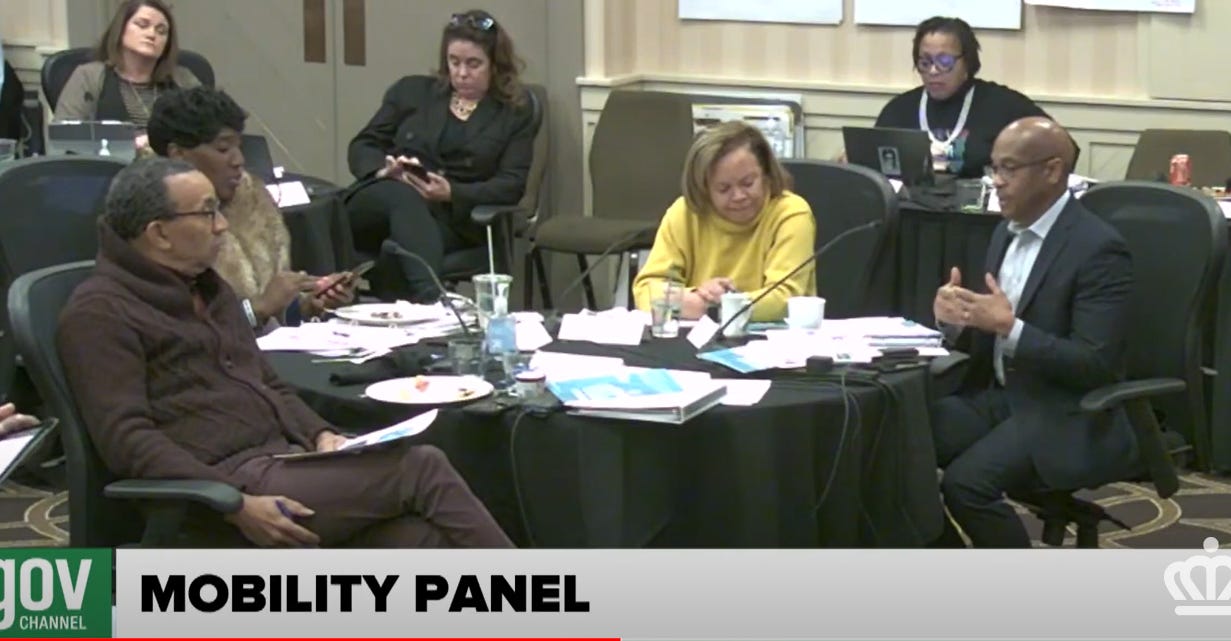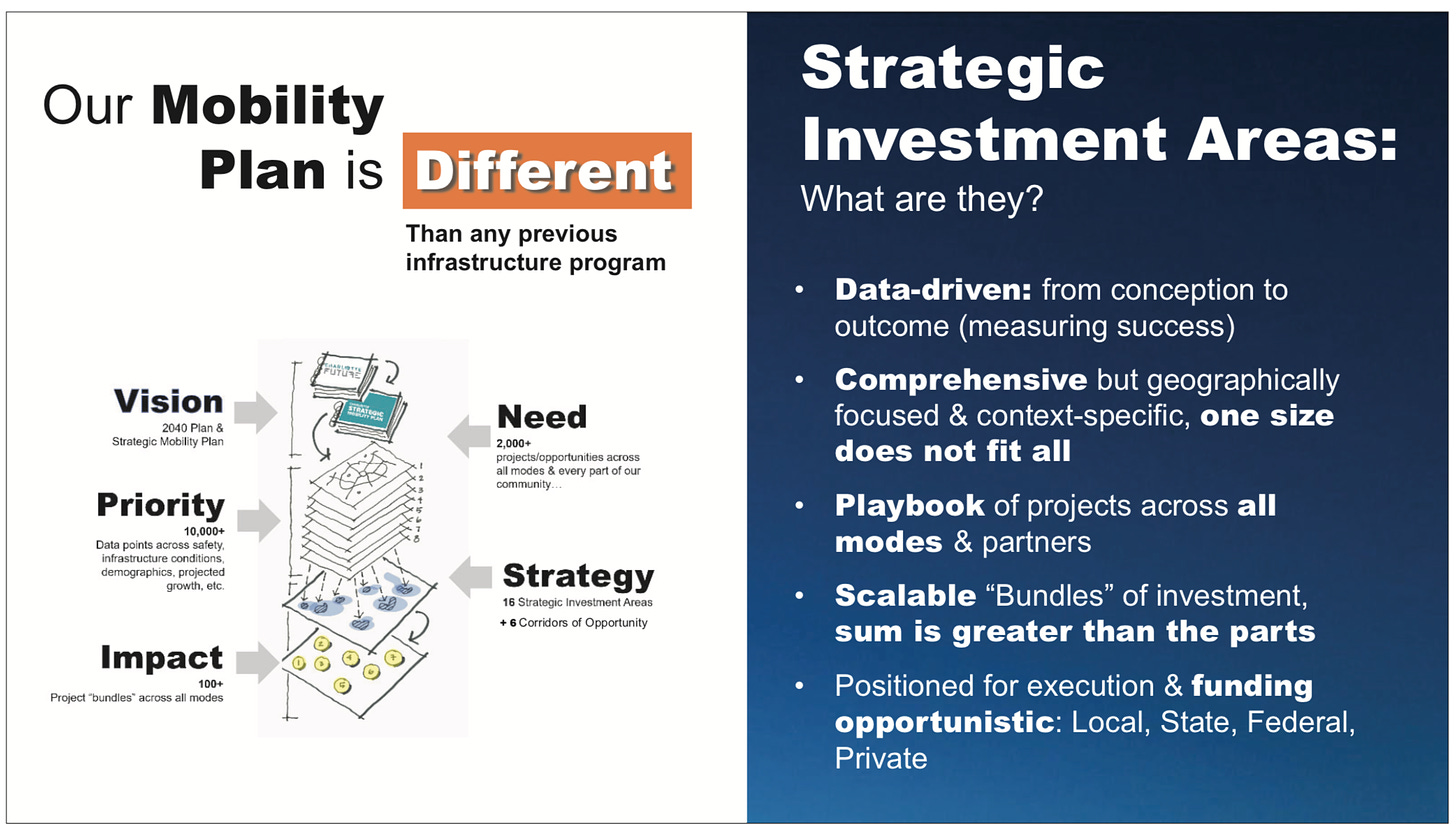Transit update: Same plan, new talking points
The Charlotte City Council discussed the stalled transit plan for more than 2 hours at a retreat this week
You’re reading Transit Time, a weekly newsletter for Charlotte people who leave the house. Cars, buses, light rail, bikes, scooters … if you use it to get around the city, we write about it. Transit Time is produced in partnership between The Charlotte Ledger and WFAE.
With little progress on transit after almost 5 years, city staff at a city council retreat outline ‘roads-first’ ideas — but how different would a revised plan really be?
by Steve Harrison
WFAE
WINSTON-SALEM—The Charlotte City Council discussed its $13.5 billion transportation and mobility plan for more than two hours at its annual planning retreat in Winston-Salem on Tuesday — and after almost five years of planning, Charlotte looks to be about where it started.
Here are the main takeaways:
No vote on transit tax this year: City Manager Marcus Jones said there will not be a vote in 2024 on a penny sales tax increase to fund the plan. Without that, the plan won’t advance.
Red Line talks ongoing: Brent Cagle, interim director of the Charlotte Area Transit System (CATS), said the city and Norfolk Southern railroad are discussing the logistics of how they could share its freight tracks in north Mecklenburg, which would allow the Red Line commuter line to move forward. But he said the two sides haven’t reached a deal. Those talks started last summer.
Building support before approaching legislature: Charlotte Mayor Vi Lyles said she hasn’t spoken recently to Republican legislative leaders about whether they would allow Charlotte to place the penny sales tax increase on the ballot. She wants to have support first from the Mecklenburg towns, most notably Davidson, Cornelius and Huntersville, which would be served by the Red Line. It’s a position that essentially places the Red Line as another precondition for moving ahead at all with the transit plan, and the Red Line has been stalled for about 20 years.
City Manager Marcus Jones (right) said there can’t be a sales tax referendum in 2024
All of it together paints a picture of a transit and mobility plan that could be headed back to the drawing board after half a decade of minimal progress. While that’s the news (or lack of news), there was still a lot said and unsaid during the discussion:
◼️ City staff are talking about the plan as something other than what it is.
Under the current plan, more than 60% of the money would be spent on rail transit. The Silver Line is estimated to cost $8 billion (though that’s probably gone up) and the Red Line at least $500 million (that has also likely increased as well). The plan also envisions money to extend the Lynx Blue Line to Ballantyne, as well as possibly extend the Gold Line streetcar.
There is also new money to expand the bus system.
But city staff appear to be rebranding the plan as something other than rail-centric. Ed McKinney, a special assistant to the city manager for mobility, did not mention the Silver Line or Red Line during his presentation Tuesday.
He did use the phrase “roads-first” and focused on smaller transportation/mobility projects that could be “bundled” together, like new streets, greenways, bike lanes and expanded intersections. He also talked about “mobility hubs,” which are enhanced transit stops that give people places to park their bikes and call for ride-share companies.
In saying “roads-first,” he may mean the city would build some of those projects before the trains start running. Framing a plan as “roads-first”is likely meant to appeal to Republican legislative leaders, who have generally shown little interest in new light rail and prefer more roads.
But most of the money in the Charlotte Moves plan would not go to roads. On Wednesday, toward the end of the three-day retreat, council member Tariq Bokhari questioned whether the discussion was a “marketing exercise” and said a roads-first plan can’t coexist with the Silver Line.
“It is mathematically impossible to have what we’re calling a roads-first plan and the Silver Line together. There’s just not enough money,” he said.
◼️ City staff members never talked about ridership or how the plan might relieve congestion.
Although the city is saying the plan is “data-driven,” there wasn’t a single slide or discussion about how many people ride CATS today and how many might ride it in the future after the plan is built. There was also no detailed discussion of how many cars it might take off the road.
At-large city council member Dimple Ajmera asked a panel consisting of invited transit officials from Miami, Jacksonville and Denver about their systems’ ridership. But no one asked Charlotte officials what’s going on here.
(For the record, in the last three months, CATS has carried about 62% of the passengers it did during the same period in 2019. If you compare it to the transit system’s peak a decade ago, CATS is carrying only half as many riders as it did in 2013.)
Ridership isn’t the only benefit from transit — new rail lines can also drive development patterns — but it seems like a reasonable thing to talk about.
A ‘DIFFERENT’ PLAN, WITH ‘BUNDLES’: A presentation to City Council this week was light on specifics but said the “mobility plan” is “data-driven,” “comprehensive but geographically focused & context specific” and has “scalable ‘Bundles’ of investment” in which the “sum is greater than the parts.” (Slide courtesy of the city of Charlotte)
◼️ There also was no discussion about work-from-home.
A big reason that transit ridership is down is that many people are still working remotely post-pandemic. The City Council never discussed whether this will continue and how it impacts transit today.
What’s surprising (or not surprising, to be honest) is that earlier this month, city officials gave a presentation to a City Council committee about what they called a crisis in the commercial real estate market across the city, due in part to people working from home.
The topic of that conversation wasn’t about transit, but about a possible new incentive program to help fill or repurpose older uptown office towers. Former developer Ned Curran even floated the idea of demolishing obsolete officer towers.
But when the topic switched to transit, the city glossed over those problems. And with the Blue Line, Silver Line, Red Line and Gold Line all focused on bringing people to and from uptown, that seems like a big omission.
◼️ Light rail will remain a part of the city’s transit ambitions.
After the meeting, Erik Spanberg of the Charlotte Business Journal asked Mayor Vi Lyles whether there was any way the plan could move forward without the $8 billion Silver Line, which would run from Matthews to the airport.
Lyles said, essentially, no.
“I think you have heard about people saying the Silver Line should go to the airport,” Lyles said, while adding that the Red Line also has to be built.
But it’s worth noting that the city has already decided to divide the Silver Line into two phases. The first would run from Matthews to uptown; the second phase would run from uptown to the airport.
That means the airport train might not open until 2050 — a quarter century from now.
If serving the airport is critical, should the city build that part of the train first?
Steve Harrison is a reporter with WFAE, Charlotte’s NPR news source. Reach him at sharrison@wfae.com.
Transit Time is a production of The Charlotte Ledger and WFAE. You can adjust your newsletter preferences on the ‘My Account’ page.
Did somebody forward you this newsletter and you need to sign up? You can do that here:
Other affiliated Charlotte newsletters and podcasts that might interest you:
The Charlotte Ledger Business Newsletter, Ways of Life newsletter (obituaries) and Fútbol Friday (Charlotte FC), available from The Charlotte Ledger.
The Inside Politics newsletter, available from WFAE.








Sounds like it was a really productive THREE days. How do these folks not lose their mind in the boredom of getting nothing done?